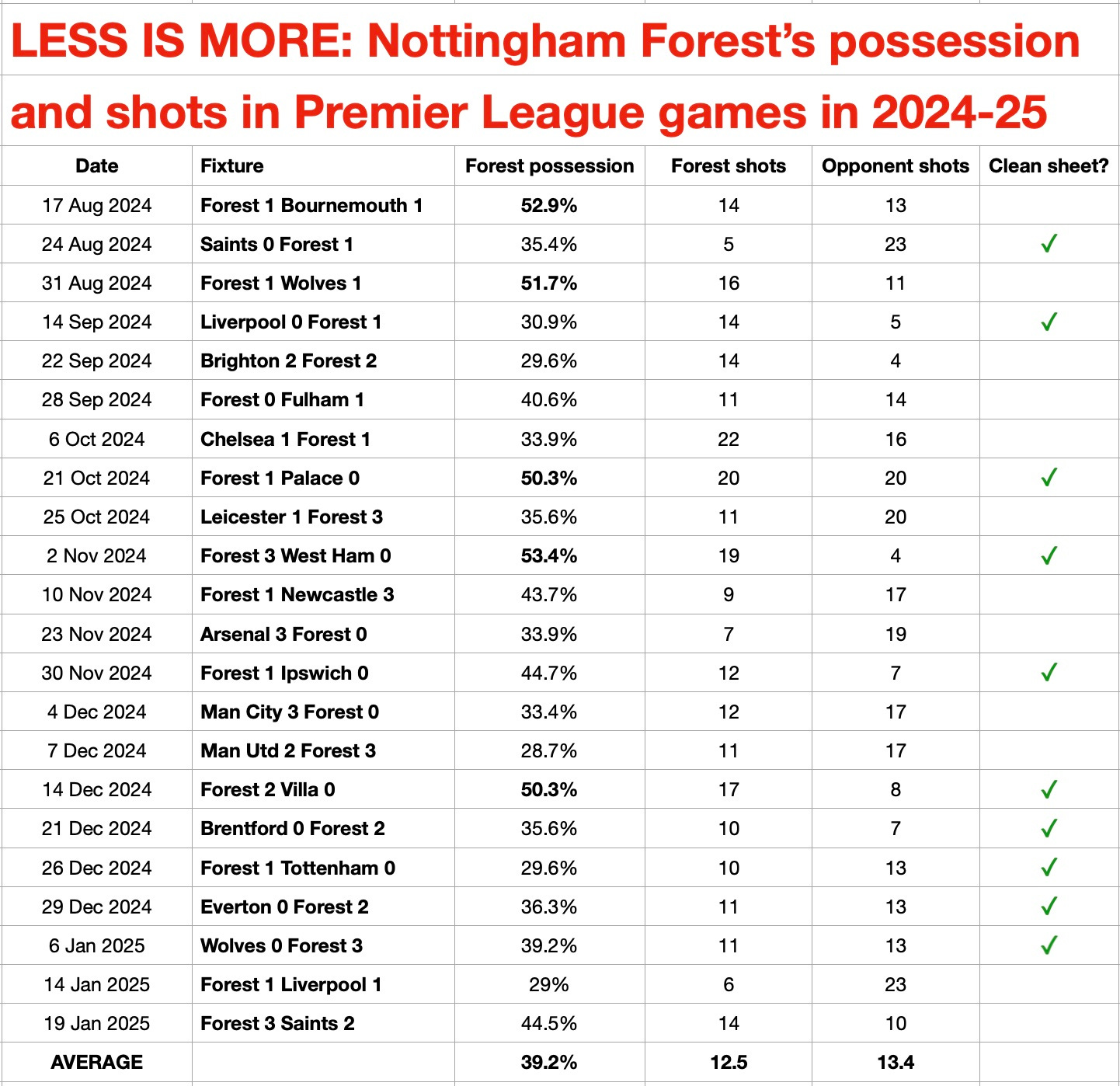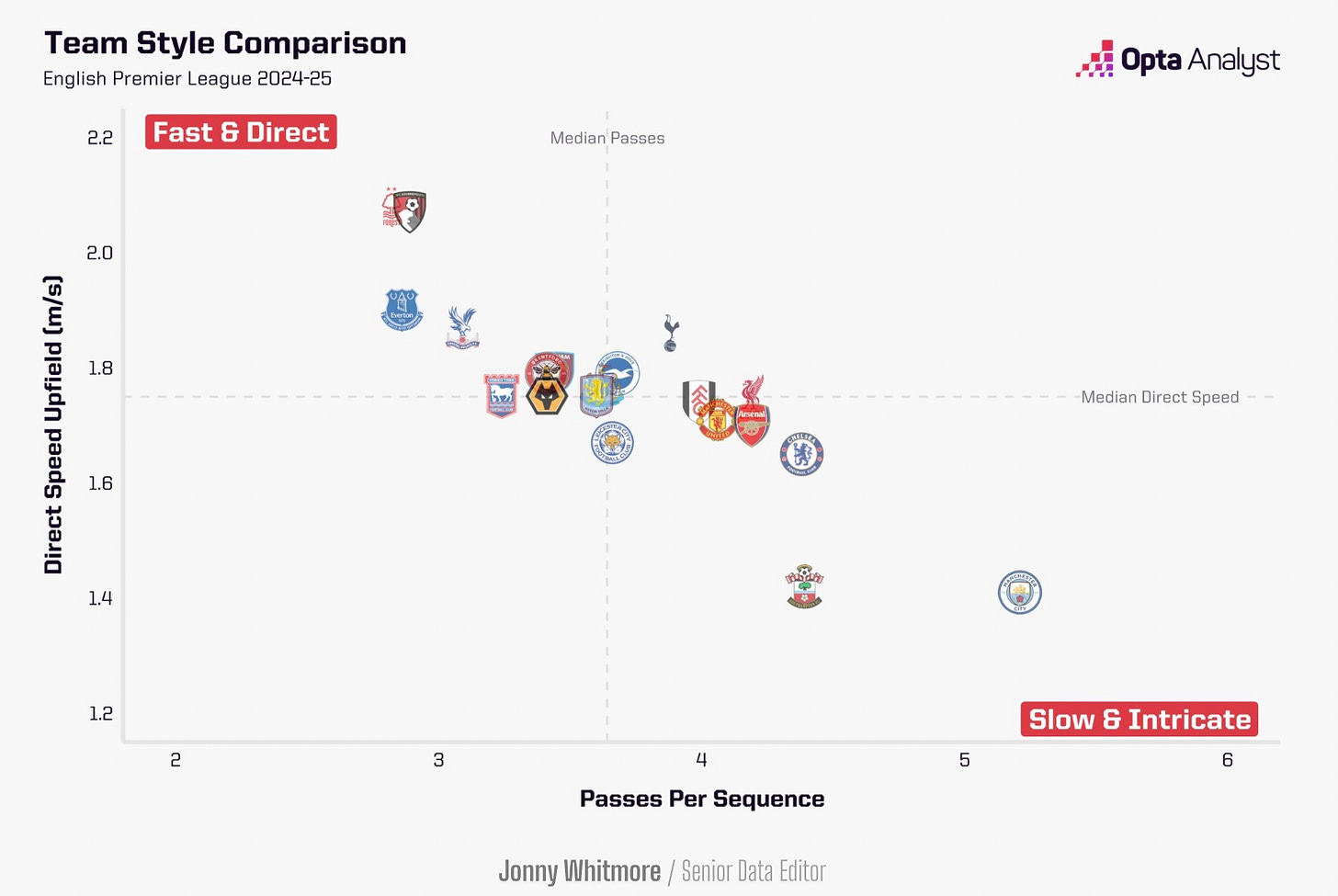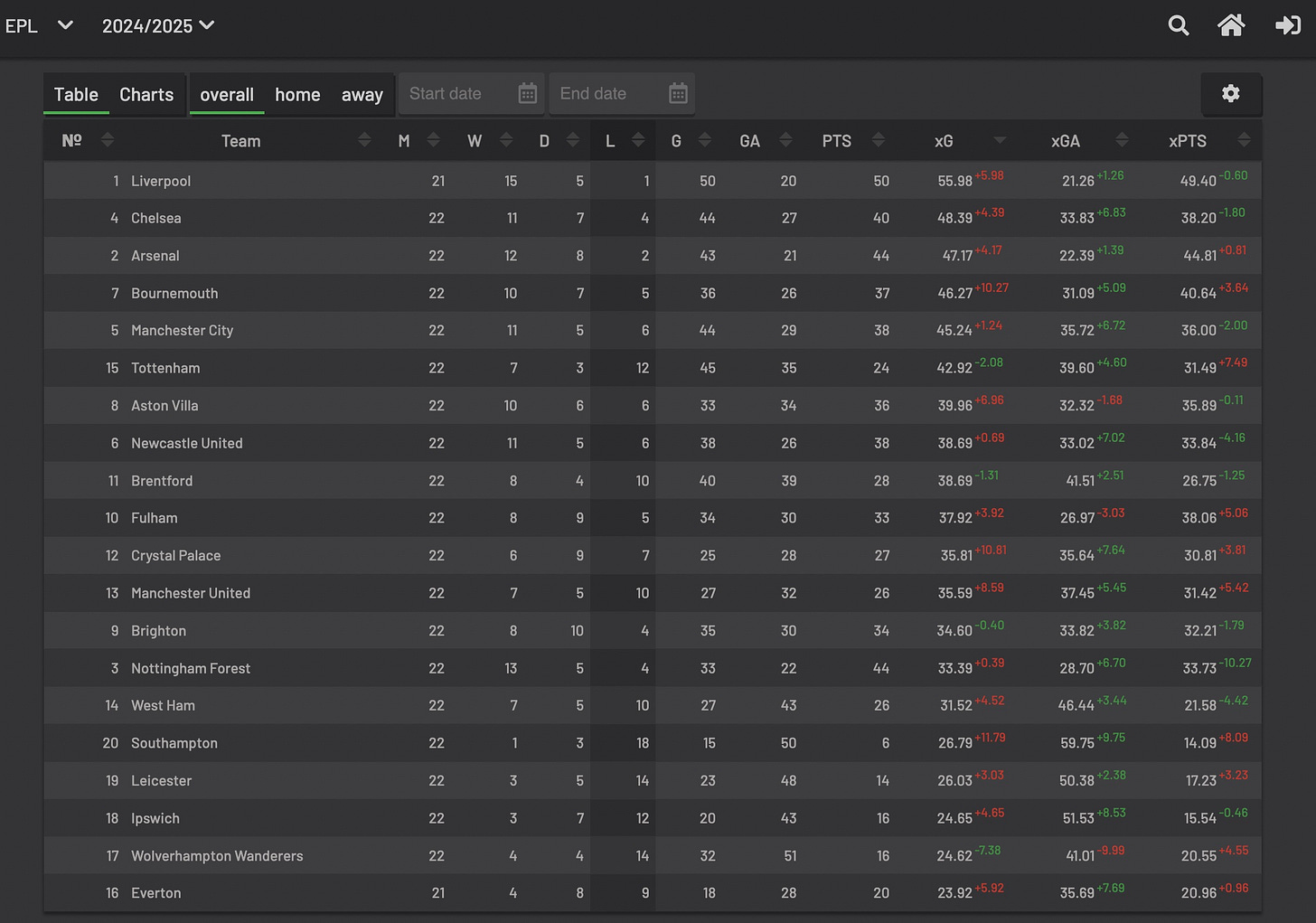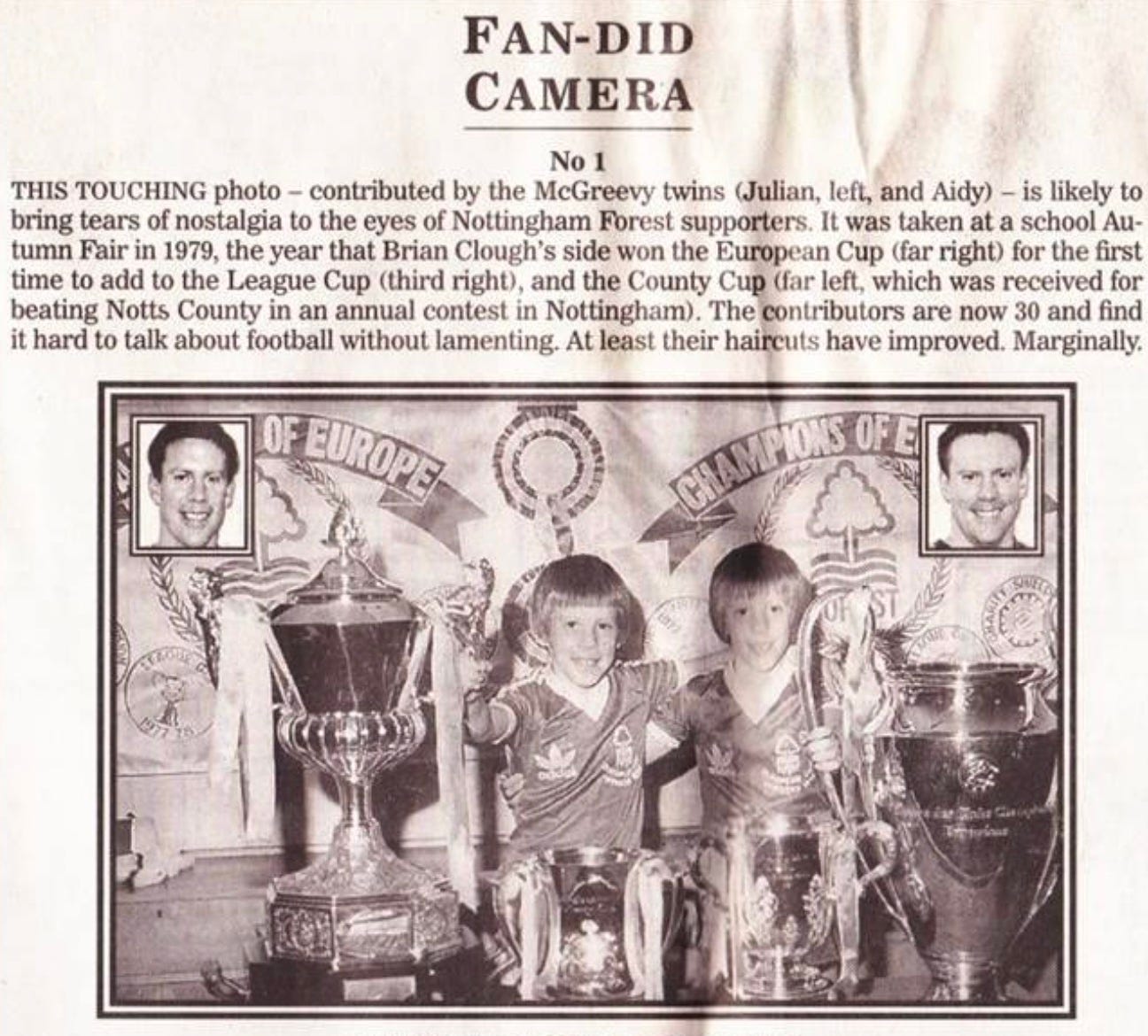Something for the weekend: Forest are tearing up trees and it's good for the game
The former - and unlikely - double champions of Europe are in contention again for the Champions League. Their brilliant season is bucking narratives, and it's inspirational
If I said I had a soft spot for Nottingham Forest, I’d be lying - more of which shortly - but what they are achieving in the Premier League this season is remarkable, and worth examining in detail.
What are they doing to achieve this, and how? Is it replicable?
This is particularly relevant to supporters of “smaller” clubs, who aspire to their own team “doing a Leicester” one day, by miraculously winning a top-flight title or even “just” qualifying for the Champions League.
There are arguably six of those “smaller” clubs among the 10 clubs currently in the top half of the Premier League table. I write that with no disrespect at all to Newcastle, currently in sixth place, or Aston Villa, in eighth.
They are both grand old clubs with rich histories and lots of silverware, but Newcastle haven’t won England’s top-flight title since 1927, and their last “big” trophy was the 1955 FA Cup.
Aston Villa’s last trophy was the 1996 League Cup, and yes, they won the English title as “recently” as 1981 and followed it up with the European Cup in 1982, but Villa have had slim pickings relative to the PL-era “big” clubs in the past 40 years.
The other “smaller” clubs in the current top 10 are Fulham (10th, never won a major trophy in their history), Brighton (9th, ditto), Bournemouth (7th, ditto), and Forest (3rd, who have won lots of major trophies, but not for 35 years and more).
All these clubs should serve as inspiration to fans of “small” clubs because they are finding a way to do things by being smarter, not by spending big.
Which brings me to my long-term lack of a soft spot for Forest. When they were the miracle club of the late 1970s and 1980s, under the genius of Brian Clough, he guided them to England’s top-flight title in 1978, then back-to-back European Cup wins in 1979 and 1980, as well as four League Cups between 1978 and 1990.
And I was growing up in Nottingham at that time … as a Southampton fan, who had no choice but to be a Southampton fan.
Ludicrous as it might sound today, Forest and Southampton were close rivals in the era between 1978 and 1985, when they met 16 times in all competitions, winning seven each and drawing twice.
Forest had seven players capped by England in that period, collectively winning 52 caps across those years and they were Peter Shilton, Tony Woodcock, Viv Anderson, Trevor Francis, Garry Birtles, Larry Lloyd and Peter Davenport.
Saints had six players capped by England in this period, collectively winning 100 caps across those years and they were Dave Watson, Kevin Keegan, Peter Shilton, Dave Armstrong, Steve Williams and Mark Wright.
Most of my mates were Forest fans, and the few that weren’t supported the dominant team of the 1970s, Liverpool.
Given that Southampton were approximately as good as Forest from when I was nine until about 15 or 16, I really didn’t like Forest. I didn’t appreciate their success. I didn’t like their players - although many years later got to know a few of them.
And, as a young teenager, I had absolutely zero idea of the extent to which what Cloughie was doing was so remarkable. He was just Brian Clough, who I would meet frequently.
Clough’s brother owned a paper shop (and post office) in Bramcote, a village in Nottinghamshire about three miles from where we lived. Every Sunday morning on the way home from church*, we would stop there for my dad to buy his cigarettes** and for us to get our weekly sweets or chocolate.
* My upbringing as a Catholic is the main reason for my atheism.
** He was a GP.
Cloughie would invariably be in there, helping out behind the counter. I got his autograph multiple times and he always signed: “Be good, Brian Clough.”
On one summer day in 1980, Cloughie came to our house. Forest had just signed a prolific young striker called Peter Ward from Brighton, where Ward had scored almost a goal every other game over the previous five years.
Ward’s wife, Sue, was the daughter of one of my mum’s friends, Sheila. Sue and Pete had two daughters, Rachael and Rebekah, and they were visiting my mum while Brian Clough personally took Peter to look at houses they might want to buy.
Cloughie pulled up outside our house. I was 10 at the time and could see him in the driver’s seat, waiting, and I went out to say hello, wearing my Southampton scarf, and with my autograph book.
I walked to the driver’s window and he wound it down and said: “Young man, what is that around your neck?”
And I replied: “It’s my Southampton scarf, Mr Clough.”
And without looking at me, he said, in a genuinely disdainful manner: “I would not wipe my nose on that thing!”. And then he wound up his window and stared straight ahead, waiting for Peter to come out of the house and get in his car.
It had been a little more than a year before that Forest won the European Cup for the first time with a starting XI of Peter Shilton, Viv Anderson, Larry Lloyd, Kenny Burns, Frank Clark, Trevor Francis, John McGovern, Ian Bowyer, John Robertson, Garry Birtles and Tony Woodcock. The bench included Martin O’Neill and Archie Gemmill.
When Forest won the European Cup again a year later, not long before Cloughie came to our house, his winning team was much the same but with Gary Mills and Frank Gray now involved.
But enough about miracles now hazy from multiple decades past.
How can a club as moderate as Forest (in financial terms, relatively) be flying so high and doing so well, with what appears to be a realistic chance of a top-four finish, if not the title this season?
Below I’ll consider:
The assembly of the squad that has got them this far, this season.
The possession-lite approach in their 22 Premier League games so far in 2024-25.
The “fast and direct” way that they break and pick off opponents.
The bedrock defensive stability that has underpinned this season.
The fragile attacking reliance on one man in attack that might yet hurt them.
How Forest assembled this top-four squad
If you cast your mind back to the summer of 2022, after Forest were promoted via the Championship play-off win over Huddersfield, they embarked on a monumental trolley dash of player acquisitions that included buying no fewer than 27 players, and taking another five on loan.
During a nervy season, they were eventually safe in 16th place in 2022-23, before following that up with a 17th-place finish last season.
This season they are flying, and the first graphic below details the 18 players who have played the most league matches in 2024-24, ranked from the top by the highest number of starts and including all players who have started at least one game and / or made double-digit league appearances including as a sub.
Only one of those 18 players, a Forest academy product, midfielder Ryan Yates, was with Forest prior to 2022. Only three others were among the 27 buys from summer 2022: Morgan Gibbs-White, Neco Williams and Taiwo Awoniyi.
Six more players were acquired in 2023: Ola Aina, Murillo, Chris Wood (permanently, after a loan), Callum Hudson-Odoi, Anthony Elanga and Nicolas Dominguez.
There is a solid case to made that those six players have been pivotal to what is happening now, and they were all acquired after the appointment of Ross Wilson - who formerly excelled at Rangers and Southampton - as “chief football officer” at Forest.
The other eight players who have played most in the league this season were all signed in 2024, all of them in the summer except keeper Matz Sels, who arrived in the winter window.
Here is a summary of Forest’s 18 key players this season, who had an average purchase price of £10.9m and have an average age of 26.2.
Recruitment has moved from haphazard to brilliant between 2022 and now.
A reliable spine, built on a formidable defence
The next graphic shows the “most common” Forest XI in the league this season, or rather the 11 players who have started most league games.
It’s clear from the most basic stats that Forest are thriving more because of their defence than their attack. They have conceded just 22 goals in 22 PL games, or the third-fewest in the division after Liverpool (20 in 21) and Arsenal (21 in 22).
Yet only eight teams in the division have scored fewer goals than Forest’s 33, and those eight clubs are all in the bottom nine clubs in the current table.
Forest’s bedrock defence is based on their keeper Sels, centre-halves Murillo and Milenkovic, and full-backs Aina on the right, and Williams (a natural right-back) on the left.
Summer signing Anderson, and Yates (and sometimes Dominguez) sit in front of them, and behind Elanga, Gibbs-White and Hudson-Odoi, in turn behind the resurgent 33-year-old Kiwi frontman, Wood.
If there is one concern for Forest, it’s that Wood alone has scored 14 of their 33 goals, or 42 per cent.
At Liverpool, top scorer Mo Salah has scored 18 of Liverpool’s 50 goals (36 per cent). At Arsenal, top scorer Kai Havertz has scored eight of Arsenal’s 43 goals (19 per cent). At Chelsea, Cole Palmer has scored 14 of their 44 league goals (32 per cent). At Man City, Erling Haaland has scored 17 of their 44 league goals (39 per cent). And so on.
No top-flight team is more reliant on a single forward player for goals than Forest are currently reliant on Wood. This is why Forest are reportedly in a continued hunt for Brentford’s Yoane Wissa (11 PL goals in 18 starts this season) and / or Wolves’s Matheus Cunha (10 PL goals in 19 starts).
Nuno not possessed with keeping the ball
Forest have been transformed under Nuno Espírito Santo, appointed as Steve Cooper’s successor in December 2023, although it’s really only in the current season that they have been consistently solid. They won only four of 23 games in all competitions between January 2024 and the end of last season.
This campaign has seen a major transformation and the next graphic illustrates how Forest have bucked the trend for possession-based, play-from-the-back football that most teams in England’s top division now try to execute.
Forest, in fact, have the lowest average possession rate in the whole of the Premier League, at an average of 39.2%. They have had a majority of possession in just five of their 22 league games this season, and have never had more than the 53.4% possession they had in their 3-0 win over West Ham in November.
Their lowest possession rate was 28.7% away at Manchester United in December, when they won 3-2. That victory was the first in a streak of six straight league wins, the other five all coming with clean sheets.
Fast and direct: the antithesis of Pep-ball
I could write in detail about the philosophy and reality of what Nuno’s Forest have been doing this season, which is, in the simplest terms, letting opponents have the ball a lot, in non-dangerous areas, and then hitting them on the break whey they lose possession.
But there’s already a brilliant article from the past few days by the folk from OPTA analysts, who go through it all in detail, with lots of graphics. I highly recommend it.
This next graphic is theirs, and is self-explanatory, showing how Forest play fast and direct, while at the other end of the spectrum, Man City play “slow and intricate.”
In that OPTA piece, there are other key technical statty details, not least:
“Forest’s passing sequences begin – on average – just 39.2 metres from their own goal-line, meaning they’re also the second-deepest side in the Premier League this term.
This reflects how Forest are content to let their opponents keep the ball in areas where they’re unlikely to cause damage. It also goes some way to explaining why they don’t exactly fit into the trend of relentlessly pressing high up the pitch.
Their 128 high turnovers – winning the ball back within 40m of the opponents’ goal – is the third fewest in the league, and their PPDA (opposition passes per defensive action) of 16.2 is the highest. That means Forest allow their opponents 16.2 passes, on average, before they try to win the ball back.”
The bedrock defence
I’m sure that the vast majority of readers will be familiar with xG (expected goals) and xGA (expected goals against). As mentioned earlier, Forest have conceded the third-fewest goals in the PL this season but their xGA - which might be taken as an objective measure of the meanness of their defence if you remove “luck” is also great, or the fourth lowest in the league.
Forest’s defence, with this particular goalkeeper and their two best centre-halves and two good full-backs, is authentically and consistently brilliant.
The over-reliance on one striker
On the flip side, Forest have an xG of just over 33, which is ranked just 14th of the 20 clubs. And Chris Wood personally is personally punching way above his weight with his 14 goals.
If he were suddenly unavailable, through injury or otherwise, we would expect Forest’s scoring to “revert to the mean", or in non-statto terms, drop off. Which is why Forest are focussing on signing another proven striker.
(Both the graphic immediately above and the one below are from Understat).
The fans’ eye view
As mentioned earlier, most of my friends growing up were Forest fans and they include twins Aidy and Julian. When I was a journalist at The Independent in 2000, we introduced a feature to the Saturday paper called “Fan-did camera” where we invited readers to send in their football-related photos for publication.
Did you have a selfie with Dennis Bergkamp in Tesco? Did you meet David Ginola on a canal holiday? Etc etc.
The first ever picture we used was of Aidy and Julian at their 1979 school Autumn Fair, pictured with the European Cup, League Cup and County Cup. That’s the pic below.
We’re still friends, us and several others, all of them Forest fans, and I sent our WhatsApp group a message two days ago asking them for their considered views of why Forest are doing so well this season.
They’re all cock-a-hoop, by the way, and can’t really believe this season is unfolding as it is. They also regularly revel in Saints’s inevitable relegation.
Anyway, Aidy replied: “I think, more than anything, for me personally, is that we have a superstar in the making: Morgan Gibbs-White. He brings so much energy to the team and controls the flow of play when Forest break out from defence.
“Having seen him live a few times this season, he is so good at control in tight areas and getting Forest up the pitch quickly for their counter attacks. It's obviously a team effort but, in my humble opinion, his energy (and high skill level) permeates through the whole team, giving everyone else confidence.”
And Julian said: “Forest’s style is like counter-punching in boxing: soak up punches/ hit suddenly and quickly. And maybe now it’ll become more common, at least for teams with limited budgets, as a reaction to Guardiola’s high press/ high possession which has dominated for a decade.”
Another friend, Mark, helpfully contributed: “Cloughie’s ghost has appeared to Nuno, like it did to Scrooge in A Christmas Carol.”
And a fourth friend, Pat, said: “Murillo.”
Make of that what you will.
Last but not least, I can recommend this piece from Forest fan and iPaper football writer Daniel Story. It’s worth your time and also cities Nuno’s willingness to cede possession, set piece defending, tactical tweaks after going ahead, the value of Anderson and Gibbs-White, wingers as second strikers, and team spirit.












